Manuscript accepted on : 28-02-2020
Published online on: --
Plagiarism Check: Yes
Reviewed by: Vikas Guleria
Second Review by: Francisco Solano ![]()
Marwa E. El-Sesy1* and Belal N.A.Mahran2
and Belal N.A.Mahran2
1Microbiology Department, Central Laboratory for Environmental Quality Monitoring (CLEQM), National Water Research Center (NWRC), Cairo, Egypt.
2Organic Department, Central Laboratory for Environmental Quality Monitoring (CLEQM), National Water Research Center (NWRC), Cairo, Egypt.
Corresponding Author E-mail : marwa.micro@gmail.com
DOI : http://dx.doi.org/10.13005/bbra/2823
ABSTRACT: This study expounded the ability to use Psidium guajava leaves extract as coagulant, fecal coliform removal and for decreasing values of some heavy metals. The optimum dosages of Psidium guajava leaves extracts needed for treatment the collected wastewater samples were studied. The Physico-chemical characterization and bacteriological analysis for wastewater samples were determined before and after treatment. Results demonstrated that the turbidity removal is observed up to 73 % and fecal coliform removal about 97% using 1.5 mg/L of Psidium guajava leaves ethanol extract. There is a marked decrease in the values of some heavy metals as copper, zinc, chromium, cadmium and lead values. The antimicrobial activity of leaves extracts against some pathogenic bacteria using disc diffusion method and viability test was examined, revealed bactericidal effect on Staphylococcus aureus, Bacillus cereus and E. coli. Studying the ultra-structure of E. coli and Bacillus cereus cells treated with MICs extracts of Psidium guajava leaves revealed the deformation of cells accompanied with rupture of cell membranes at certain sites and leakage of cellular contents. Using gas chromatograph Mass Spectrometry (GC-MS), to identify chemical compositions of Psidium guajava leaves extract and their bioactive components indicate the presence of β-Caryophyllene and Alpha-Bisabolol that reveled the biological activities of Psidium guajava as Antimicrobial. Psidium guajava leaves extract seems to be environmental friendly and an effective agent in treatment wastewater.
KEYWORDS: Antibacterial Activity; Extracts; Heavy Metal, Gc-Ms; Psidium Guajava; Wastewater
Download this article as:| Copy the following to cite this article: El-Sesy M. E, Mahran B. N. A. The Antibacterial and Coagulant Activity of Psidium Guajava Leaves Extracts in Purification of Wastewater. Biosci Biotech Res Asia 2020;17(1). |
| Copy the following to cite this URL: El-Sesy M. E, Mahran B. N. A. The Antibacterial and Coagulant Activity of Psidium Guajava Leaves Extracts in Purification of Wastewater. Biosci Biotech Res Asia 2020;17(1). Available from: https://bit.ly/2VF8PSI |
Introduction
Surface water was polluted in different ways either by sewage or industrial wastewater [1]. Coagulants have a large role in the treatment of wastewater and also in sludge elimination. Many inorganic coagulants that used in the traditional treatment process may leave some residues after treatment process can cause several health hazards [2]. Natural coagulants must have a large interest because their environmentally friendly behavior so they are appearing to be safe for human health and also reported as low-cost products [3]. Therefore, it is necessary to replace the inorganic coagulants with alternative natural coagulants.
Treated water with Psidium guajava extract seem to be environmental friendly, an effective agent as well as an inexpensive in treatment water, especially in removing some heavy metals , suspended solids and as a coagulant where appeared to be effective in clarifying turbidity[1] [4].
Psidium guajava known as guava has edible fruit and belongs to the family Myrtaceae [5]. It is known for their richness in biologically active secondary metabolites and essential oils of therapeutic relevance [6]. Different parts of Psidium guajava are used in the treatment of different human disease such as wounds, bowels, dysentery, gastroenteritis , diarrhea and cholera and has a long history in the folk medicinal uses in Egypt and worldwide [7][8].
Psidium guajava leaves extracts were examined showing their biological activities and used as antimicrobial, antibacterial, antioxidant, anti-allergy, anti-inflammatory, and antitussive activities in traditional medicine [9] [10].
Inhibitory effects of Psidium guajava extract on S. aureus and E. coli have been reported with different degrees [11]. Additionally, a study explained that Psidium guajava contains a number of organic constituents that possess antimicrobial activities belonging mainly to phenolic, flavonoid, carotenoid, terpenoid and triterpene compounds [12]. Wastewater containing heavy metals from industrial activities cause environmental danger, highly toxic and carcinogenic. Heavy metals such as chromium, lead, cadmium and copper are the major dangerous environmental pollutants due to their mobility in water streams. Earlier studies discussed using guava leaves to absorb some heavy metals as metal ions Cr that has a great toxicity [13]. The main sources of Cr in wastewater are metallurgical, electroplating, leather, and paint industries [14].
The objectives of this study were to test the antibacterial and coagulant activity of Psidium guajava leaves extracts in treatment the collected wastewater samples.
Materials and Methods
Water Samples Source
Wastewater samples were collected from outfall of Belbies drain– Egypt using plastic bottles (1liter capacity) and insulated by photo (1). The samples were stored in the refrigerator at 4 ˚C after collection.
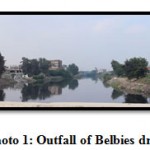 |
Photo 1: Outfall of Belbies drain |
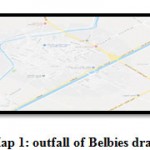 |
Map 1: Outfall of Belbies drain |
Plant Sample
Psidium guajava leaves were brought from Agricultural Research Center, Cairo- Egypt.
Preparation of Plant Material
The leaves were collected in a large quantity and then washed with distilled water then dried in shade in room temperature. To constant moisture from dried leaves entered to oven at 40 °C. This was followed by grinding in grinding machine then kept away from moisture in a well closed container.
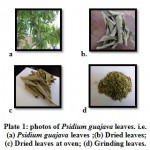 |
Plate 1: photos of Psidium guajava leaves. |
Preparation of Plant Extract
Ethanolic Extract
Ten grams of dried leaves were socked in 100 ml of ethanol for 48 h then filtered through Whatman filter paper no.1; filtrate was dried by using a rotary evaporator at 60 °C. the dried extract was stored in sterile glass bottles at 20 °C until use [15].
Water Extract
Ten grams of dried leaves were socked in 100 ml of sterile distilled water. Shaken flasks for 15 minutes. The obtained extracts were filtered through Whatman No. 1filter paper. Then through 0.45 sterile membrane filter. The extract allowed evaporating and the residues were dried to constant weight. The dried extracts were weighed and dissolved in appropriate volume of water to be used in the subsequent antibacterial activity assay [16].
Detection and Isolation of Bacterial Isolates
Detection and Isolation of Escherichia Coli
Escherichia coli was determined as CFU 100 ml-1 using modified m TEC agar medium and incubated at 44 ˚C for 24hrs[17]. .Colonies of Escherichia coli. were streaked on Xylose-Lysine-Desoxycholate agar plate (XLD Agar) at 35 ˚C for 24 hrs.
Detection and Isolation of Staphylococcus Aureus
Staphylococcus aureus was determined as CFU 100 ml-1 using Bared-Parker agar medium and incubated at 35 ˚C for 48 hrs. [16].
Detection and Isolation of Bacillus Cereus
Bacillus cereus was determined as CFU 100 ml-1 using mannitol egg yolk polymyxin (MYP) agar medium [18]. About 0.1 ml was transferred to duplicate plates of poured well dried mannitol egg yolk polymyxin agar medium. The inoculum was spread evenly over the surface of each plate with a sterile glass rod and incubated at 35 °C for 48 hrs.
Antibacterial Activity of Psidium Guajava Extracts using Disc Diffusion Method
Purified and identified bacterial isolates of Bacillus cereus, Staphylococcus aureus and E. coli obtained from the collected water samples were inoculated in liquid nutrient broth media and incubated at 37 ˚C for 24 hrs. The final inoculum of the tested organism was adjusted to 105 cfu / ml and seeded in Nutrient agar (Difco) plates.
Ethanol and water extracts of the Psidium guajava were tested for their antibacterial activity using disc diffusion method [19]. Sterile filter paper discs (6mm diameter) were impregnated with 100µl of extract dilutions (20-100 mg/ml) and placed on surface of seeded agar plates. Filter paper discs impregnated with sterile water were used as control. Plates were then incubated at 37 oC for 48 hrs. The experiment was carried out in duplicate and the antimicrobial activity was determined as inhibition zones (mm) around filter paper discs.
Determination of Minimum Inhibitory Concentrations (MIC) and Minimum Bactericidal (MBC) of Psidium Guajava Extract
Determination of MIC and MBC was carried out using broth dilution method [20]:
Determination of MIC
0.5 ml of the extract concentration (100, 80, 60, 40 and 20 mg/ml) were added to 2 ml of Nutrient broth (Difco) of the following composition (g/liter): (5.0g peptone; 3.0g Beef extract and 1.0L distilled water) was added. Loopfuls of test strains suspensions (adjusted at 105 cfu / ml) were introduced into the tubes each separately. Nutrient broth tubes seeded with test strains served as control. Tubes were then incubated at 37o C for 24 hrs. and examined for bacterial growth by measuring light absorbance at A600.
Determination of MBC
Loopfuls of broth from tubes which did not show any visible growth (MIC) were streaked on surface of sterile Nutrient Agar plates and incubated at 37o C for 24 hrs. The concentration at which no visible growth was seen was noted as MBC.
Transmission Electron Microscopy (TEM)
Control viable test bacterial strains (Bacillus cereus and E. coli) and treated cells with half MIC of ethanol extract of Psidium guajava were investigated after loading on CU-grids using TEM. The used microscope is JEOL JEM 1010 ExII transmission electron microscopy (JEOL, Tokyo, Japan) operating at 120 KV at Faculty of Science, Alazher University.
Treatment the Collected Wastewater Sample with the Best Psidium Guajava Leaves Extract
This test was done using a drainage wastewater sample and treated with the best extracts of Psidium guajava leaves. The Physico-chemical characterization and bacteriological analysis for water samples were determined before and after treatment. The raw sample was divided into three bottles of one liter and using different concentration of the extract then left after shaking for 24 h.
Physico-Chemical Characterization of the Collected Water Samples Before and After Treatment
The following parameters were carried out [16]; (EC) electrical conductivity and (pH) Hydrogen-ion concentration were measured using EC-meters and the Orion digital pH . The concentration of total dissolved solids (TDS) was determined gravimetrically and the concentration of dissolved oxygen (DO) was measured using WTW. The concentration of ammonia (NH3) was analyzed by Kjeldahl,s method and titration method respectively. (BOD) biological oxygen demand was analyzed using Orion BOD fast respirometry system and the chemical oxygen demand (COD) was analyzed using a HACH 2000 spectrophotometer at 600 nm wavelength. Major anions including chloride, nitrate, phosphate and sulfate (using Ion Chromatography IC), as well as, major cations including calcium, potassium, magnesium and sodium (using Inductively Coupled Plasma – Emission Spectrometry (ICP – ES, Perkin Elmer Optima 3000, USA, with Ultra Sonic Nebulizer USN). The heavy metals (Al, As, Cd, Cr, Co, Cu, Fe, Pb, Mn, Mo, Ni, Se, St, Sn, V, and Zn) were also detected using the same instrument.
Bacteriological Characteristics of a Wastewater Sample before and After Treatment
The Bacteriological characteristics of water samples before and after treatment was carried out according to [16] that was including; the total viable bacteria at 35 °C and 22 °C by pour plate method using plate count agar medium (Difco, USA), total coliforms, fecal coliforms by membrane filter technique using m-Endo agar LES medium (Biolife, Italy), m-FC agar medium (Merck, Germany), Escherichia coli (Difco, USA), Bacillus cereus (Oxoid) and Staphylococcus aureus (Merck, Germany).
Gas Chromatography-Mass Spectrometry (Gc-Ms) Analysis
Agilent technologies 7890A gas chromatograph system with an Agilent technologies 5975C intert with triple axis detector with capillary column HP-5MS (30 m× 0.25 mm ×0.25 μm film thicknesses) was used. The ethyl extract were injected under certain conditions. Helium was used as a carrier gas at a flow rate 0.86 mL/min. the injection size was 1.9 Ml. No signal acquired for a min after injection in pulsed splitless mode. The mass spectrometric detector was operated in electron impact ionization mode with an ionizing energy of 70 e.v. scanning from 45-450 m/z. The temperature of injector was set at 230°C. The electron multiplier voltage (EM voltage) was maintained 1250 v above auto tune. The initial GC temperature was at 30 ˚C (2 min), elevate to 140 ˚C for 6 ˚C min. then increased to 280 °C about 3 mints and held at that temperature during the analysis. Mass spectral data base of Wiley Nist and Wiley was used in the identification of the obtained peaks at Egyptian Petroleum Research Institute.
Results
Detection and Isolation of Bacterial Isolates from Wastewater Samples
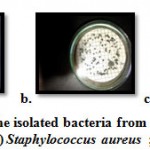 |
Plate 2: Photos of the isolated bacteria from wastewater samples. |
Antibacterial Activity of Water and Ethanolic Extracts of Psidium Guajava Leaves
Antibacterial activity of water and ethanolic extracts of leaves were illustrated by figures (1&2) and plates (3, 4 & 5). The results showed that two extracts were active against the test organisms indicating that leaves extract are very adequate. Water extract was less potent than the ethanolic extracts. S. aureus was the most resistance strain of bacteria used in this study. While E. coli was the most susceptible bacterium of the tested bacterium.
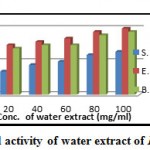 |
Figure 1: Antibacterial activity of water extract of Psidium guajava leaves. |
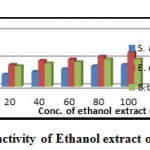 |
Figure 2: Antibacterial activity of Ethanol extract of Psidium guajava leaves |
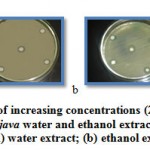 |
Plate 3: Effect of increasing concentrations (20-1000 mg/ml) |
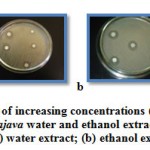 |
Plate 4: Effect of increasing concentrations (20-100 mg/ml) |
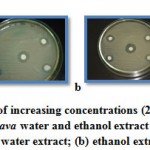 |
Plate 5: Effect of increasing concentrations (20-100mg/ml) |
Determination of Minimum Inhibitory Concentrations (MIC) and Minimum Bactericidal (MBC) of Psidium Guajava Extract
The MICs and MBCs values of water extracts of Psidium guajava against S. aureus was (5, 9 mg/ml), E. coli (1.25, 2.4 mg/ml) and Bacillus cereus (2.5, 5 mg/ml), while MICs and MBCs values of ethanolic extracts of Psidium guajava leaves against was S. aureus (1.2, 2.4 mg/ml), E. coli (0.33, 0.620 mg/ml) and Bacillus cereus (0.620, 0.620 mg/ml) illustrated by figure (3).
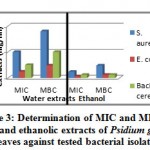 |
Figure 3: Determination of MIC and MBC of Water |
Effect of Ethanol Extract of Psidium Guajava Leaves against Gram +ve & Gram –ve Pathogenic Bacteria under Transmission Electron Microscopy (TEM):
Control and treated vegetative cells of Bacillus cereus & Escherichia coli with half MIC of Psidium guajava ethanol extract were investigated under TEM after preparation. Plate 6 include photo (A) of Bacillus cereus untreated showing normal rods, complete cell walls, in addition to well delineated membranes and regular cytoplasmic regions. Photo (B) of Bacillus cereus incubated with ethyl extracts showed uneven rippling of the cell membrane and aggregations of shrunken cells. Cytoplasm leaked was observed. Photo (c) of untreated E. coli considered as control cells revealed good membrane integrity as seen by electron –dense lines. While treated E. coli cells in photo (d) showed cracks in cell wall .uneven distribution, and loss of cytoplasm.
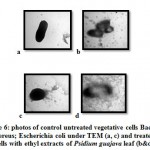 |
Plate 6: photos of control untreated vegetative cells Bacillus cereus |
Water Quality Assessment for the Collected Water Samples before and after Treatment with Ethanol Extract of Psidium Guajava Leaves
Bacteriological and Physico-chemical characterization for outfall of Belbies drain sample before and after treatment data recorded in table (1&2).
Table 1: Physico-chemical characterization for outfall of Belbies drain sample before and after treatment.
|
Parameter |
Unite |
Before treatment
|
After treatment with Extract Conc g//L |
Law (92) |
||||||||||||||||
| 0.5 g | 1 g |
1.5g |
||||||||||||||||||
| Physicochemical Parameters | ||||||||||||||||||||
| Temp | °C | 29 | 29 | 29 | 29 | 3> | ||||||||||||||
| pH | 7.57 | 7.57 | 7.57 | 7.57 | 6.5-8.5 | |||||||||||||||
| Carbonate | mg/l | 0.0 | 0.0 | 0.0 | 0.0 | |||||||||||||||
| Turbidity | NTU | 22.8 | 15 | 10 | 6 | – | ||||||||||||||
| Electrical Conductivity | ms/cm | 1.34 | 1.01 | 0.88 | 0.36 | – | ||||||||||||||
| Total Dissolved Solids | mg/l | 857.6 | 646.4 | 563.2 | 230.4 | 1000 | ||||||||||||||
| Bicarbonate – | mg/l | 350 | 300 | 240 | 190 | |||||||||||||||
| Ammonia | mg/l | 15.8 | 12 | 9 | 5 | – | ||||||||||||||
| Major Cations | ||||||||||||||||||||
| Calcium | mg/l | 88 | 80 | 70 | 65 | – | ||||||||||||||
| Potassium | mg/l | 32 | 25 | 20 | 16 | – | ||||||||||||||
| Magnesium | mg/l | 50 | 44 | 39 | 30.8 | – | ||||||||||||||
| Sodium | mg/l | 77 | 73 | 71 | 66 | – | ||||||||||||||
| Major Anions | ||||||||||||||||||||
| Chloride | mg/l | 122.2 | 120 | 111 | 109 | – | ||||||||||||||
| Nitrate | mg/l | >0.2 | >0.2 | >0.2 | >0.2 | – | ||||||||||||||
| Phosphate | mg/l | >0.2 | >0.2 | >0.2 | >0.2 | – | ||||||||||||||
| Sulfate | mg/l | 94.7 | 92 | 90 | 88 | – | ||||||||||||||
| Trace Metals | ||||||||||||||||||||
| Aluminum | mg/l | 2.909 | 2.908 | 2.908 | 2.907 | – | ||||||||||||||
| Antimony | mg/l | >0.004 | >0.004 | >0.004 | >0.004 | – | ||||||||||||||
| Arsenic | mg/l | >0.001 | >0.001 | >0.001 | >0.001 | 0.01 | ||||||||||||||
| Barium | mg/l | 0.076 | 0.071 | 0.069 | 0.060 | – | ||||||||||||||
| Cadmium | mg/l | 1.445 | 1.091 | 0.895 | 0.044 | 0.00 | ||||||||||||||
| Chromium | mg/l | 2.911 | 2.089 | 1.511 | 0.072 | 0.05 | ||||||||||||||
| Cobalt | mg/l | 0.037 | 0.035 | 0.033 | 0.029 | – | ||||||||||||||
| Copper | mg/l | 0.035 | 0.034 | 0.033 | 0.025 | >1 | ||||||||||||||
| Iron | mg/l | 0.85 | 0.79 | 0.74 | 0.70 | >3 | ||||||||||||||
| Lead | mg/l | 0.091 | 0.080 | 0.050 | 0.040 | >0.1 | ||||||||||||||
| Manganese | mg/l | 0.049 | 0.045 | 0.043 | 0.040 | >2 | ||||||||||||||
| Molybdenum | mg/l | >0.001 | >0.001 | >0.001 | >0.001 | – | ||||||||||||||
| Nickel | mg/l | 0.249 | 0.248 | 0.247 | 0.247 | 0.10 | ||||||||||||||
| Selenium | mg/l | >0.001 | >0.001 | >0.001 | >0.001 | 0.01 | ||||||||||||||
| Strontium | mg/l | 0.381 | 0.380 | 0.380 | 0.379 | |||||||||||||||
| Tin | mg/l | >0.004 | >0.004 | >0.004 | >0.004 | – | ||||||||||||||
| Vanadium | mg/l | >0.002 | >0.002 | >0.002 | >0.002 | – | ||||||||||||||
| Zinc | mg/l | 0.021 | 0.019 | 0.017 | 0.011 | 2> | ||||||||||||||
| Organic Parameters | ||||||||||||||||||||
| BOD | mg/l | 120 | 80 | 50 | 27 | – | ||||||||||||||
| COD | mg/l | 148 | 110 | 100 | 90 | >50 | ||||||||||||||
| DO | mg/l | 0.2 | 3.4 | 4.5 | 5 | ˃5 | ||||||||||||||
Law (92): i.e. the Egyptian law (92) for wastewater limits
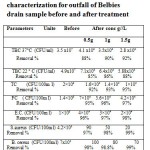 |
Table 2: The Removal % of some Physico-chemical characterization |
 |
Table 3: The Removal % of some Physico-chemical characterization |
Analysis of Ethanol Extract of Psidium Guajava Leaves by GC-MS:
GC/MS is used for detection of the existing components in conventional plants. Ethanol extract of Psidium guajava leaves by GC/MS evaluated the presence of 25 different compounds having different concentrations. The compounds with their molecular formula, molecular weight (MW), concentration (%) and retention time (RT) were illustrated by photo (2) and data recorded in table (3).
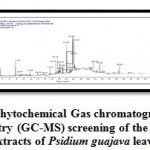 |
Photo 2: Phytochemical Gas chromatography-mass spectrometry (GC-MS) |
Table 4: GC-MS identified components of the crude ethanolic extracts of Psidium guajava leaves
| No | Rt (min) | Name of compound | Molecular formula | Mol .wt. | Peak area% |
| 1 | 3.672 | 2-Methylbutanoic acid, methyl ester | C6 H12 O2 | 116.15 | 0.27 |
| 2 | 7.936 | D-Limonene | C10H16 | 136.234 | 0.58 |
| 3 | 8.436 | 1,3,3-Trimethyl-2-oxabicyclo[2.2.2]octane | C10H18O | 154.25 | 1.27 |
| 4 | 11.891 | 5,7-Octadien-2-OL, 2,6-Dimethyl | C10H18O | 154.253 | 0.21 |
| 5 | 13.913 | Dodecamethyl cyclohexasiloxane | C12H36O6S16 | 444.924 | 0.44 |
| 6 | 15.573 | Alpha-Copaene | C15H24 | 204.357 | 0.22 |
| 7 | 17.273 | β-Caryophyllene | C15H24 | 204.35 | 18.76 |
| 8 | 19.035 | (-)-Aromadendrene II | C15H24 | 204.357 | 0.45 |
| 9 | 19.72 | (+)-D-Cadinene | C15H24 | 204.357 | 1.29 |
| 10 | 20.029 | 2,6-dimethyl-6-(4-methylpent-3-en-1-yl)bicyclo[3.1.1]hept-2-ene | C15H24 | 204.357 | 0.38 |
| 11 | 20.371 | Cis-alpha-Bisabolene | C15H24 | 204.357 | 1.08 |
| 12 | 20.824 | Trans-Nerolidol | C15 H26O | 222.372 | 20.97 |
| 13 | 20.989 | Beta-Caryophyllene oxide | C15 H24O | 220.356 | 9.55 |
| 14 | 21.945 | Humulene epoxide | C15 H24O | 220.356 | 0.69 |
| 15 | 22.207 | D-germacrene | C15 H24 | 204.357 | 0.49 |
| 16 | 22.917 | 2-Bromoadamantane | C10H15Br | 215.134 | 0.77 |
| 17 | 23.011 | Aromadendrene | C15 H24 | 204.357 | 2.99 |
| 18 | 23.202 | Naphthalen-1-ol | C10H8O | 144.173 | 3.95 |
| 19 | 23.302 | Torreyol | C15H26O | 222.366 | 4.93 |
| 20 | 23.401 | (-)-Globulol | C15 H26O | 222.372 | 1.8 |
| 21 | 23.531 | Alpha-Bisabolol | C15 H26O | 222.372 | 1.25 |
| 22 | 29.402 | 1,2-Benzenedicarboxylic acid, butyl | C20 H30 O4 | 334.001 | 1.77 |
| 23 | 31.51 | 2-(2-isopropylphenoxy)propanoic acid | C12H16O3 | 208.257 | 0.81 |
| 24 | 36.967 | Di(2-ethylhexyl)phthalate | C24H38O4 | 390.564 | 0.77 |
| 25 | 47.952 | Hexadeca-2,6,10,14-tetraen-3-ol | C16H26O | 234.383 | 0.92 |
Discussions
Several studies have been carried out on using plant extracts as natural coagulants and this seem to be safe for human health. This study aimed to investigate the possible use of Psidium guajava leaves extract for treating wastewater samples. Special focus is placed on lowering turbidity, removal of suspended solids, elimination of pathogenic bacteria and their antibacterial activity on some bacterial strains.
ethanolic extract of Psidium guajava leaves caused total viable bacterial counts removal in the treated wastewater sample about (88%) and (92%) using 1.5g of extract for 22ºC and 37°C populations, respectively.
while FC, Escherichia coli, Staphylococcus aureus and Bacillus cereus removal were about (95, 98, 99 and 99 %%) respectively using 1.5 g of Psidium guajava ethanolic extract. Likewise, a study reported that Psidium guajava leaf extract seem to be good as a natural antimicrobial agent against two gram-negative bacteria (Escherichia coli and Salmonella enteritidis) and two gram-positive bacteria (Staphylococcus aureus and Bacillus cereus) [20].
The physico-chemical characteristics of the collected wastewater sample were evaluated before and after treatment with Psidium guajava ethanolic extract. After treatment there is a significant decrease in turbidity up to 73%. That is to say that Psidium guajava extract has a good potential to be used as natural coagulant to replace chemical coagulant in removing suspended solids in water [21]. Flavonoids and tannin are coagulating agent which are naturally present in Psidium guajava leaves and they are responsible for turbidity removal in water [22]. In the present study treating wastewater samples with Psidium guajava extract caused an increase in DO values to about (3.4, 4.5 and 5) using (0.5, 1 and 1.5) g/l of extract respectively. The result indicated that by increasing the conc. of extract this causing increasing in DO. Concerning (BOD), high values were recorded in the wastewater sample (120 mg/l).Upon treatment with Psidium guajava leaves ethanol extract significant decrease in BOD value was observed up to (77%) using 1.5 g of extract. The chemical oxygen demand (COD) recorded high values. Notably, there is a decrease in some heavy metals during study such as copper, zinc, chromium, cadmium and lead values. Several studies represented that Psidium guajava leaves extracts has high efficiency in adsorption of chromium metal ions, cadmium ions ,copper and zinc ions from aqueous solution and founded to be very effective [23] [24] [25] [26]. Psidium guajava leaves contain tannins so they can use as a bio-sorbent in the absorption of heavy metals. Tannins can be found in almost all types of green plants where can used in bind heavy metals and also can absorb pathogenic bacteria [13].
The potential effect of Psidium guajava leaves water and ethanol extract on pathogenic test bacterial strains (S. aureus, E. coli and Bacillus cereus) was evaluated in the present study. Psidium guajava leaves ethanol extract showing potential effect and clear zones of inhibition against S. aureus, Bacillus cereus and E.coli more than water extract. Similarly, a study represented that ethanol extracts showed higher antimicrobial activity with (MICs >1000 μg/ml) as compared to aqueous extracts with (MICs 500 μg/ml) [27]. Many studies reported that the aqueous and ethanolic extracts of Psidium guajava leaves revealed antibacterial activity against some gram negative and positive bacteria as Staphylococcus aureus, Proteus spp., and Shigella spp [7]] [28] [7]. in like manner, The antimicrobial activity of ethanolic extracts of Psidium guajava against E. coli and S. aureus were found to be effective [29]. Another study reported that guava leaf extract have a good antimicrobial activity against nine different strains of Staphylococcus aureus [30].
Furthermore, increasing the concentrations of extract increases the inhibition zone against the growing cultures of test bacterial strains. MIC and MBC values of water extracts of Psidium guajava leaves against S. aureus was (5, 9 mg/ml), E. coli (1.25, 2.4 mg/ml) and Bacillus cereus (2.5, 5 mg/ml), respectively. While MICs and MBCs values of ethanolic extracts of Psidium guajava leaves against was S. aureus (1.2, 2.4 mg/ml), E. coli (0.33, 0.620 mg/ml) and Bacillus cereus (0.620, 0.620 mg/ml). The antibacterial activity of Psidium guajava obtained may be because the leaves contain an essential oil rich in cineol, tannins and triterpenes that are capable of damaging enteric bacteria [20].
Growing cultures of Bacillus cereus and E. coli (pathogenic test strains) treated with MICs of Psidium guajava leaves ethanol extract were examined using transmission electron microscope. It was observed that Psidium guajava leaves ethanol extract caused rupture of cell membranes at certain sites accompanied by leakage of cellular contents and shrinking of cytoplasm.
The GC-MS analysis in the study confirms that ethanolic extract of Psidium guajava contain β-Caryophyllene as (terpenoid compounds), 1, 2-Benzenedicarboxylic acid as (triterpene compounds), butyl, Di (2-ethylhexyl) phthalate, Hexadeca-2, 6, 10, 14-tetraen-3-ol, Alpha-Bisabolol are present. The present findings are in agreement with the previous work reported by Thenmozhi and Rajan [31]. These components reveled the biological activities of Psidium guajava and have antimicrobial, antibacterial, anti-inflammatory and fungicide [32].
Conclusions
It could be concluded that, the water and ethanolic extracts of Psidium guajava leaves have an antibacterial activity and showing clear zones of inhibition against S. aureus, Bacillus cereus and E.coli. Furthermore, increasing the concentrations of extract increases its bactericidal effect. This study highlights the potentials of Psidium guajava leaves extract to decrease TDS, some heavy metals and turbidity in wastewater, so it has a great eventuality to be used and replace other chemical coagulant in water treatment. In addition, Psidium guajava leaves extract is environmentally friendly, available, cheap and simple to prepare as compared to other coagulant chemicals.
Acknowledgement
We would like to thank all the staff in the Central Laboratory for Environmental Quality Monitoring (CLEQM) for their collaboration during measurements and this cause easiness to complete the work.
Conflict of interest:
The authors declare that they have no conflict of interest
Reference
- Thakur S.S and Choubey S. Use of tannin based natural coagulants for water treatment: An alternative to inorganic chemicals. International Journal of ChemTech Research, 2014, 6: 3628-3634
- Katayon S, Noor M.M.M, Asma M, Ghani L.A, Thamer A, Azni I, Ahmad J, Khor B and Suleyman A. Effects of storage conditions of moringa oleifera seeds on its performance in coagulation. Bioresource technology, 2006, 97: 1455-1460
CrossRef - Binayake R and Jadhav M. Applications of natural coagulants in water purification. International journal of advanced technology and civil engineering, 2013, 2: 118-123
- Yap L.L. Performance of rambutan seed as iron and manganese removal in groundwater. thesis. Faculty of Earth Sciences, 2013
- Sanda K, Grema H, Geidam Y and Bukar-Kolo Y. Pharmacological aspects of psidium guajava: An update. International Journal of Pharmacology, 2011, 7: 316-324
CrossRef - Lufuluabo L. G, Moke E, Bongo G. N, Liyongo C. I, Ashande C. M, Sapo B. S, Zoawe B. G and Mpiana P. T. A. review on the phytochemistry and pharmacology of Psidium guajava l.(myrtaceae) and future direction. Discovery Phytomedicine, 2018, 5: 7-13
CrossRef - Sanches N.R, Garcia Cortez A, Schiavini M.S, Nakamura C.V and Dias Filho B.P. An evaluation of antibacterial activities of Psidium guajava (l.). Brazilian Archives of Biology and Technology, 2005, 48: 429-436
CrossRef - Karawya M, Abdel Wahab S, Hifnawy M, Azzam S and El-Gohary H. Essential oil of egyptian guajava Egyptian Journal of Botany, 2000, 40: 209
- Satyal P, Paudel P, Lamichhane B and Setzer W.N. Leaf essential oil composition and bioactivity of Psidium guajava from kathmandu, nepal. Am J Essent Oils Nat Prod, 2015, 3: 11-14
- Olajide O, Awe S, Makinde J. Pharmacological studies on the leaf of psidium guajava. Fitoterapia, 1999, 70: 25-31
CrossRef - Balakrishnan N, Balasubramaniam A, Nandi P, Dandotiya R and Begum S. Antibacterial and free radical scavenging activities of stem bark of Psidium guajava International Journal of Drug Development & Research, 2011, 3: 255-260
- Gutiérrez R.M.P, Mitchell S and Solis R.V. Psidium guajava: A review of its traditional uses, phytochemistry and pharmacology. Journal of ethnopharmacology, 2008, 117: 1-27
CrossRef - Kartohardjono S, Lukman M. A, Utami C. F and Manik, G. P. Biosorption of cr (vi) by psidium guajava. Global Journal of Environmental Research, 2009, 3: 149-154
- Barkat M, Chegrouche S, Mellah A, Bensmain B, Nibou D and Boufatit M. “Application of Algerian Bentonite in the Removal of Cadmium (II) and Chromium (VI) from Aqueous Solutions”, Journal of Surface Engineered Materials and Advanced Technology, 2014, 4: 210-226.
CrossRef - Kandil O, Radwan N.M, Hassan A.B, Amer A. M.M, El-Banna H. A and Amer W.M.M. Extracts and fractions of thymus capitatus exhibit antimicrobial activities. Journal of ethnopharmacology, 1994, 44: 19-24
CrossRef - Rios J and Recio M. Medicinal plants and antimicrobial activity. Journal of ethnopharmacology, 2005, 100: 80-84
CrossRef - Rice E.W, Baird R.B, Eaton A.D and Clesceri L.S. (Eds.). Standard Methods for the Examination of Water and Wastewater. 22nd Edition, American Public Health Association APHA, American Water Works AWWA, Water Environment Federation WPCR, Washington DC,2012, 1496:.
- Mossel D, Koopman M and Jongerius E. Enumeration of bacillus cereus in foods. Applied Microbiology, 1967, 15: 650-653
CrossRef - Kiehlbauch J. A, Hannett E, Salfinger M, Archinal W, Monserrat C and Carlyn C. Use of the national committee for clinical laboratory standards guidelines for disk diffusion susceptibility testing in new york state laboratories. Journal of clinical microbiology, 2000, 38: 3341-3348
CrossRef - Doughari J, Pukuma M and De N. Antibacterial effects of balanites aegyptiaca l. Drel. And moringa oleifera lam. On salmonella typhi. African Journal of biotechnology, 2007, 6.
CrossRef - Biswas B, Rogers K, McLaughlin F, Daniels D and Yadav A.A. ntimicrobial activities of leaf extracts of guava (Psidium guajava ) on two gram-negative and gram-positive bacteria. International journal of microbiology, 2013
CrossRef - Rak A. E, Jessuta J, Prawit K and Afip L. A. Potential of Psidium guajava shoots extract as coagulant for drinking water treatment, 2015
- Aweng E, Jessuta J, Prawit K and LiyanaI A. Potential of the concoction of champereia manillana and Psidium guajava shoot extracts as coagulant for drinking water treatment,2015
- Mulana F. The effect of temperature on cr (vi) removal by using guava leaves as a biosorbent. In: Proceedings of the Proceedings of The Annual International Conference, Syiah Kuala University-Life Sciences & Engineering Chapter, 2013.
- Abdelwahab O, Fouad Y.O, Amin N.K and Mandor H. Kinetic and thermodynamic aspects of cadmium adsorption onto raw and activated guava (psidium guajava) leaves. Environmental Progress & Sustainable Energy, 2015, 34: 351-358
CrossRef - Gaikwad R. Removal of copper (ii) ions from acid mine drainage effluents using psidium guava leaves powder. Int J Adv Res, 2013, 1: 944-950
- Salim R, Al-Subu M, Abu-Shqair I and Braik H. Removal of zinc from aqueous solutions by dry plant leaves. Process Safety and Environmental Protection, 2003, 81: 236-242
CrossRef - Tachakittirungrod S, Ikegami F, Okonogi S. Antioxidant active principles isolated from Psidium guajava grown in thailand. Scientia pharmaceutica, 2007, 75: 179
CrossRef - Gnan S. O and Demello M.T. Inhibition of Staphylococcus aureus by aqueous Goiaba extracts. Journal of Ethnopharmacology, 1999,68(1-3), 103-108.
CrossRef - Rasool M, Malik A, Arooj M, Alam M. Z, Alam Q, Awan M, Asif M, Qazi M. H, Zaheer A and Khan S.U. Evaluation of antimicrobial activity of ethanolic extracts of azadirachta indica and Psidium guajava against clinically important bacteria at varying pH and temperature. Biomedical Research, 2017, 28: 134-139
- Vieira R. H. S, Rodrigues, D. D. P, Gonçalves, F. A, Menezes, F. G. R, ARAGÃO, J. S and Sousa, O. V. (2001). Microbicidal effect of medicinal plant extracts (Psidium guajava and Carica papaya Linn.) upon bacteria isolated from fish muscle and known to induce diarrhea in children. Revista do Instituto de Medicina Tropical de Sao Paulo, 2001,43: 145-148.
CrossRef - Thenmozhi S and Rajan S. Reactive oxygen and nitrogen species scavenging activity of Psidium guajava (l) leaf. Int J Curr Microbiol Appl Sci, 2015;4:410–418.
- Barnes J, Anderson L.A and Phillipson J.D. Herbal Medicines.A guide for Healthcare Professionals, third ed. Pharmaceutical Press, London, 2007. ISBN 978 0 85369 623 0

This work is licensed under a Creative Commons Attribution 4.0 International License.





